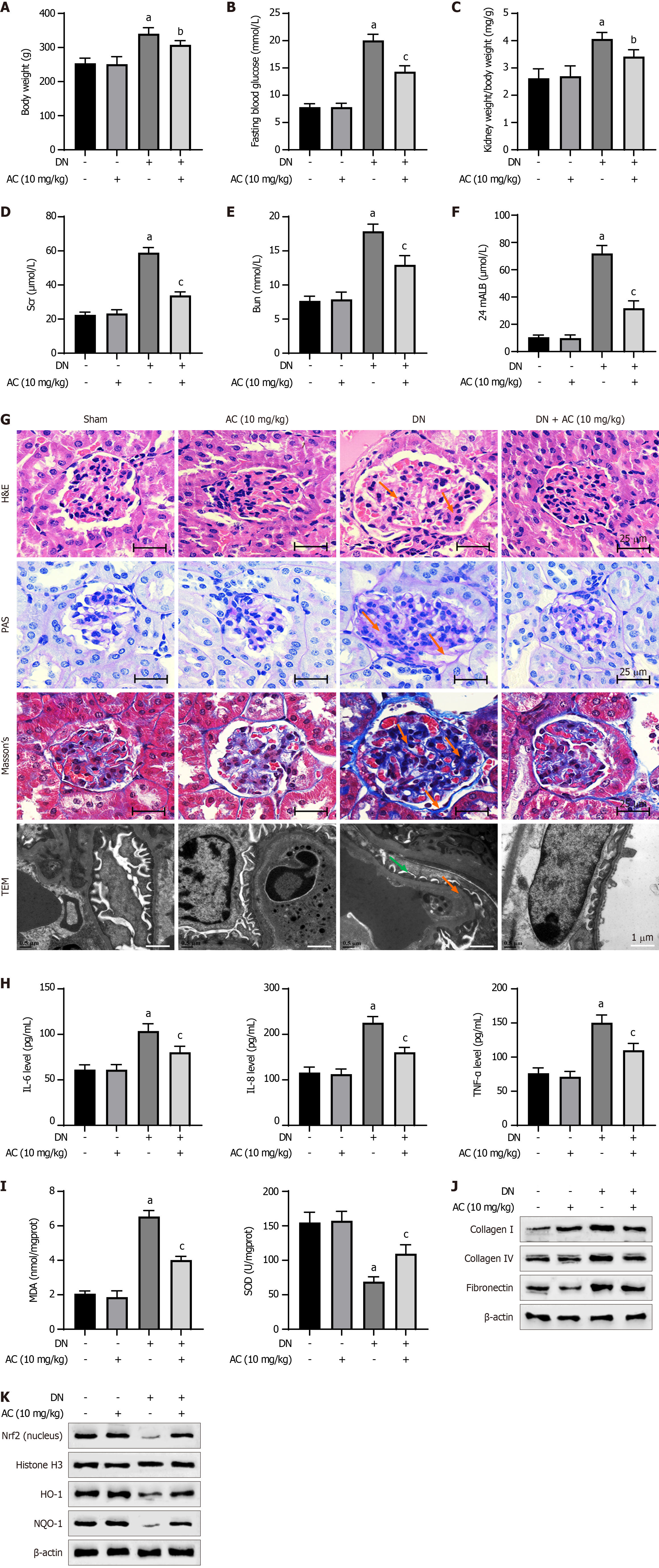Copyright
©The Author(s) 2024.
World J Diabetes. Oct 15, 2024; 15(10): 2111-2122
Published online Oct 15, 2024. doi: 10.4239/wjd.v15.i10.2111
Published online Oct 15, 2024. doi: 10.4239/wjd.v15.i10.2111
Figure 5 Asiaticoside attenuates oxidative stress and fibrosis in a diabetic nephropathy rat model.
A-F: Graphical summary of the changes in body weight, blood glucose, kidney weight/body weight ratio, serum creatinine, blood urea nitrogen, and 24-h urine protein in control, diabetic nephropathy (DN) model, asiaticoside (AC) drug, and DN + AC groups; G: Results of hematoxylin and eosin (scale bar: 25 μm, orange arrows indicate mesangial hyperplasia), Masson’s (scale bar: 25 μm, orange arrows mark collagen fiber deposition), and Periodic acid-Schiff staining (scale bar: 25 μm, orange arrows indicate glycogen deposition), as well as TEM (scale bar: 1 μm, orange arrow shows uniform thickening of the basement membrane, and green arrow indicates loss of the podocyte foot process); H and I: Graphical summary of (H) the contents of interleukin (IL)-6, IL-8, and tumor necrosis factor (TNF)-α, and (I) the contents of malondialdehyde and superoxide dismutase in rat serum of each experimental group; J: Western blot analysis of the protein expression of collagen I, collagen IV, and fibronectin; K: Protein expression of nuclear NRF2 and total heme oxygenase-1, as well as NAD(P)H dehydrogenase (Quinone) 1, in renal tissues. n = 6 animals in each group. aP < 0.001 vs Sham, bP < 0.05, and cP < 0.001 vs diabetic nephropathy. DN: Diabetic nephropathy; AC: Asiaticoside; PAS: Periodic acid-Schiff; TEM: Transmission electron microscopy; HO-1: Heme oxygenase-1; NQO-1: NAD(P)H dehydrogenase (Quinone) 1; IL: Interleukin; TNF: Tumor necrosis factor; H&E: Hematoxylin and eosin.
- Citation: Zhuang LG, Zhang R, Jin GX, Pei XY, Wang Q, Ge XX. Asiaticoside improves diabetic nephropathy by reducing inflammation, oxidative stress, and fibrosis: An in vitro and in vivo study. World J Diabetes 2024; 15(10): 2111-2122
- URL: https://www.wjgnet.com/1948-9358/full/v15/i10/2111.htm
- DOI: https://dx.doi.org/10.4239/wjd.v15.i10.2111









